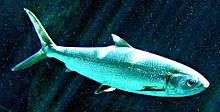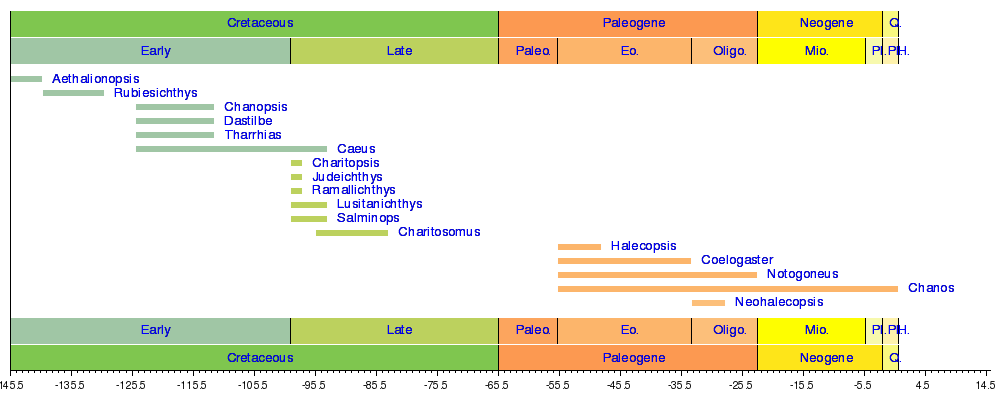Gonorynchiformes
| Gonorynchiformes Temporal range: Early Cretaceous - Recent | |
|---|---|
 | |
| Milkfish, Chanos chanos | |
| Scientific classification | |
| Kingdom: | Animalia |
| Phylum: | Chordata |
| Class: | Actinopterygii |
| Superorder: | Ostariophysi |
| Order: | Gonorynchiformes L. S. Berg, 1940 |
| Families | |
|
Chanidae (milkfish) | |
The Gonorynchiformes are an order of ray-finned fish that includes the important food source, the milkfish (Chanos chanos, family Chanidae), and a number of lesser-known types, both marine and freshwater.
The alternate spelling "Gonorhynchiformes", with an "h", is frequently seen but not official.
Gonorynchiformes have small mouths and no teeth. They are the sole group in the clade Anotophysi, a subgroup of the superorder Ostariophysi. They are characterized by a primitive Weberian apparatus formed by the first three vertebrae and one or more cephalic ribs within the head. This apparatus is believed to be a hearing organ, and is found in a more advanced and complex form in the related cypriniform fish, such as carp.[1] Also like the cypriniforms, the gonorynchiforms produce a substance from their skin when injured that dissolves into the water and acts an alarm signal to other fish.[2]
Taxonomy
Although many of the families are rather small, there are several fossil genera. This listing of the groups of Gonorynchiformes includes fossil fish with a short description.[1] They are listed in approximate order of how primitive their characteristics are.
Order Sorbininardiformes (extinct)
- Family Sorbininardidae (extinct)
- Sorbininardus (extinct) - sister group to all other Gonorynchiformes
- Family Sorbininardidae (extinct)
Order Gonorynchiformes
- Suborder Chanoidei
- Aethalinopsis (extinct) - sister group to Chanidae from Early Cretaceous.
- Family Chanidae - milkfishes
- Subfamily Rubiesichthyinae (extinct)
- Gordichthys (extinct) - Early Cretaceous Chanid
- Rubiesichthys (extinct) - Early Cretaceous Chanid
- Subfamily Chaninae
- Subfamily Rubiesichthyinae (extinct)
- Suborder Gonorynchoidei - beaked sandfishes
- Apulichthys (extinct) - primitive sister group to Gonorynchoids.
- Family Gonorynchidae
- Notogoneus (extinct) - from North America, Europe, Australia; some freshwater; Late Cretaceous to Oligocene; sister group to Gonorynchus
- Charitosomus (extinct) - Cretaceous Gonorynchid
- Judeichthys (extinct)
- Ramallichthys (extinct)
- Charitopsis (extinct)
- Gonorynchus
- Suborder Knerioidei
- Family Kneriidae
- Family Phractolaemidae
Timeline of genera

References
- Sepkoski, Jack (2002). "A compendium of fossil marine animal genera". Bulletins of American Paleontology. 364: 560. Retrieved 2011-05-17.